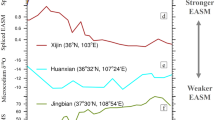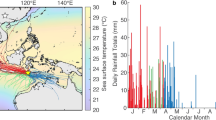Abstract
The variations of tropical precipitation are antiphased between the hemispheres on orbital timescales. This antiphasing arises through the alternating strength of incoming solar radiation in the two hemispheres, which affects monsoon intensity and hence the position of the meridional atmospheric circulation of the Hadley cells1,2,3,4. Here we compare an oxygen isotopic record recovered from a speleothem from northeast Brazil for the past 26,000 years with existing reconstructions of precipitation in tropical South America5,6,7,8. During the Holocene, we identify a similar, but zonally oriented, antiphasing of precipitation within the same hemisphere: northeast Brazil experiences humid conditions during low summer insolation and aridity when summer insolation is high, whereas the rest of southern tropical South America shows opposite characteristics. Simulations with a general circulation model that incorporates isotopic variations support this pattern as well as the link to insolation-driven monsoon activity. Our results suggest that convective heating over tropical South America and associated adjustments in large-scale subsidence over northeast Brazil lead to a remote forcing of the South American monsoon, which determines most of the precipitation changes in the region on orbital timescales.
This is a preview of subscription content, access via your institution
Access options
Subscribe to this journal
Receive 12 print issues and online access
$259.00 per year
only $21.58 per issue
Buy this article
- Purchase on Springer Link
- Instant access to full article PDF
Prices may be subject to local taxes which are calculated during checkout



Similar content being viewed by others
References
Thompson, L. G. et al. Tropical ice core records: Evidence for asynchronous glaciation on Milankovitch timescales. J. Quat. Sci. 20, 723–733 (2005).
Wang, X. et al. Millennial-scale precipitation changes in southern Brazil over the past 90,000 years. Geophys. Res. Lett. 241, 699–706 (2007).
Kutzbach, J. E., Liu, X., Liu, Z. & Chen, G. Simulation of the evolutionary response of global summer monsoons to orbital forcing over the past 280,000 years. Clim. Dyn. 30, 567–579 (2008).
Wang, X. et al. Interhemispheric anti-phasing of rainfall during the last glacial period. Quat. Sci. Rev. 25, 3391–3403 (2006).
Seltzer, G., Rodbell, D. & Burns, S. J. Isotopic evidence for Late Glacial and Holocene hydrologic change in tropical South America. Geology 28, 35–38 (2000).
Cruz, F. W. et al. Insolation-driven changes in atmospheric circulation over the past 116,000 years in subtropical Brazil. Nature 434, 63–66 (2005).
Cruz, F. W. et al. Evidence of rainfall variations in southern Brazil from trace element ratios (Mg/Ca and Sr/Ca) in a Late Pleistocene stalagmite. Geochim. Cosmochim. Acta 71, 2250–2263 (2007).
van Breukelen, M. R., Vonhof, H. B., Hellstrom, J. C., Wester, W. C. G. & Kroon, D. Fossil dripwater in stalagmites reveals Holocene temperature and rainfall variation in Amazonia. Earth Planet. Sci. Lett. 275, 54–60 (2008).
Nobre, P. & Shukla, J. Variations of sea surface temperature, wind stress, and rainfall over the tropical Atlantic and South America. J. Clim. 9, 2464–2479 (1996).
Hastenrath, S. Interannual and longer-term variability of upper-air circulation in the Northeast Brazil—Tropical Atlantic Sector. J. Geophys. Res. 105, 7327–7335 (2000).
Claussen, M., Ganopolski, A., Brovkin, V., Gerstengarbe, F.-W. & Werner, P. Simulated global-scale response of the climate system to Dansgaard/Oeschger and Heinrich events. Clim. Dyn. 21, 361–370 (2003).
Arz, H. W., Pätzold, J. & Wefer, G. Correlated millennial-scale changes in surface hydrography and terrigenous sediment yield inferred from last glacial marine deposits off northeastern Brazil. Quat. Res. 50, 157–166 (1998).
Peterson, L. C., Haug, G. H., Hughen, K. A. & Röhl, U. Rapid changes in the hydrologic cycle of the tropical Atlantic during the last glacial. Science 290, 1947–1951 (2000).
Haug, G. H., Hughen, K. A., Sigman, D. M., Peterson, L. C. & Röhl, U. Southward migration of the intertropical convergence zone through the Holocene. Science 293, 1304–1308 (2001).
Wang, X. et al. Wet periods in northeastern Brazil over the past 210 kyr linked to distant climate anomalies. Nature 432, 740–743 (2004).
Rodwell, M. J. & Hoskins, B. J. Subtropical anticyclones and summer monsoons. J. Clim. 14, 3192–3211 (2001).
Lenters, J. D. & Cook, K. H. On the origin of the Bolivian High and related circulation features of the South American climate. J. Atmos. Sci. 54, 656–677 (1997).
Chen, T. C., Weng, S. P. & Schubert, S. Maintenance of austral summertime upper-tropospheric circulation over tropical South America: The Bolivian High-Nordeste Low system. J. Atmos. Sci. 56, 2081–2100 (1999).
Hagos, S. M. & Cook, K. H. Influence of surface processes over Africa on the Atlantic marine ITCZ and South American precipitation. J. Clim. 18, 4993–5010 (2005).
Cruz, F. W., Burns, S. J., Karmann, I., Sharp, W. D. & Vuille, M. Reconstruction of regional atmospheric circulation features during the late Pleistocene in subtropical Brazil from oxygen isotope composition of speleothems. Earth Planet. Sci. Lett. 248, 494–506 (2006).
Vuille, M., Bradley, R. S., Werner, M., Healy, R. & Keimig, F. Modeling δ18O in precipitation over the tropical Americas: 1. Interannual variability and climatic controls. J. Geophys. Res. 108, 4174 (2003).
Sifeddine, A. et al. A 21000 cal years paleoclimatic record from Caço Lake, Northern, Brazil: Evidence from sedimentary and pollen analyses. Palaeogeogr. Palaeoclimatol. Palaeoecol. 189, 25–34 (2003).
Jaeschke, A., Rühlemann, C., Arz, H., Heil, G. & Lohmann, G. Coupling of millennial-scale changes in sea surface temperature and precipitation off northeastern Brazil with high-latitude climate shifts during the last glacial period. Paleoceanography. 22, PA4206 (2007).
Wang, X., Edwards, R. L., Auler, A. S., Cheng, H. & Ito, E. Millennial-scale interhemispheric asymmetry of low-latitude precipitation: Speleothem evidence and possible high-latitude forcing. Geophys. Monogr. Ser. 173, 279–293 (2007b).
Hoffmann, G., Werner, M. & Heimann, M. Water isotope module of the ECHAM atmospheric general circulation model: A study on timescales from days to several years. J. Geophys. Res. 103, 16871–16896 (1998).
Thompson, L. G. et al. Late Glacial stage and Holocene tropical ice core records from Huascaran, Peru. Science 269, 46–50 (1995).
Vuille, M. & Werner, M. Stable isotopes in precipitation recording South American summer monsoon and ENSO variability—observations and model results. Clim. Dyn. 25, 401–413 (2005).
Harrison, S. P. et al. Mid-Holocene climates of the Americas: A dynamical response to changed seasonality. Clim. Dyn. 20, 663–688 (2003).
Liu, Z., Otto-Bliesner, B., Kutzbach, J., Li, L. & Shields, C. Coupled climate simulation of the evolution of global monsoons in the Holocene. J. Clim. 16, 2472–2490 (2003).
Liu, Z., Harrison, S. P. & Kutzbach, J. E. Otto-Bliesner, Global monsoons in the mid-Holocene and oceanic feedback. Clim. Dyn. 22, 157–182 (2004).
Acknowledgements
We thank M. H. Hollanda, L. Mancine and A. Barros for all the support during the stable isotope data acquisition at the University of São Paulo. We are grateful to IBAMA/C. Mendes for permission to collect stalagmite samples, and in particular to J. Cruz for helping us in the field. This work was supported by the Fundação de Amparo a Pesquisa do Estado de São Paulo (FAPESP), Brazil (grant to F.W.C and I.K.).
Author information
Authors and Affiliations
Corresponding author
Supplementary information
Supplementary Table S1
Supplementary Information (PDF 1004 kb)
Rights and permissions
About this article
Cite this article
Cruz, F., Vuille, M., Burns, S. et al. Orbitally driven east–west antiphasing of South American precipitation. Nature Geosci 2, 210–214 (2009). https://doi.org/10.1038/ngeo444
Received:
Accepted:
Published:
Issue Date:
DOI: https://doi.org/10.1038/ngeo444
This article is cited by
-
Summer insolation controlled movements of Intertropical Convergence Zone during last glacial cycle in northern South America
Communications Earth & Environment (2023)
-
South American precipitation dipole forced by interhemispheric temperature gradient
Scientific Reports (2022)
-
Fishing intensification as response to Late Holocene socio-ecological instability in southeastern South America
Scientific Reports (2021)
-
Reconstructing Holocene landscape and environmental changes at Lago Rogaguado, Bolivian Amazon
Journal of Paleolimnology (2021)
-
Inter-hemispheric synchroneity of Holocene precipitation anomalies controlled by Earth’s latitudinal insolation gradients
Nature Communications (2020)



